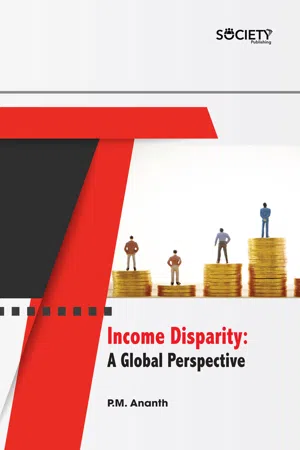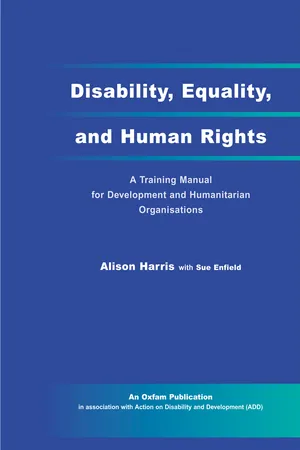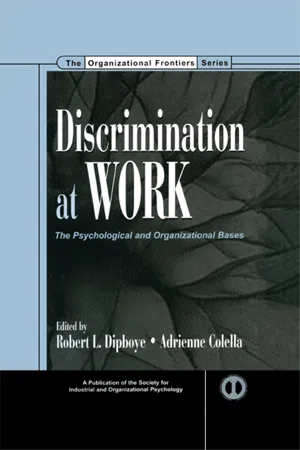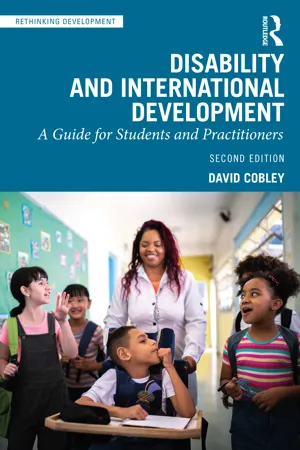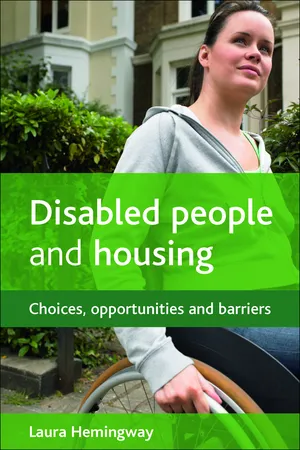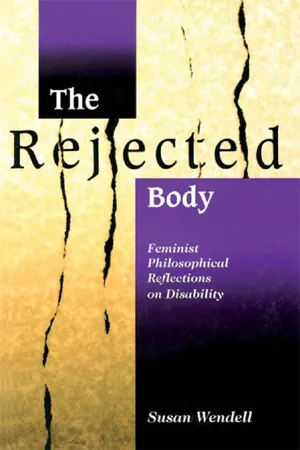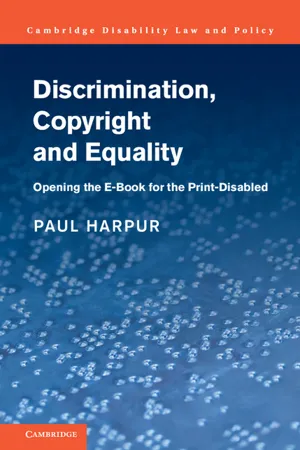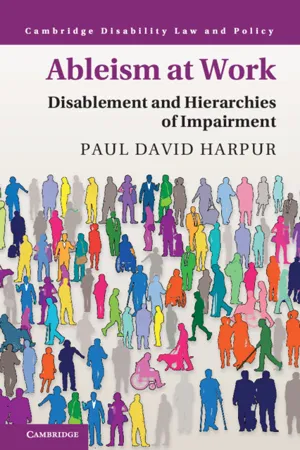Social Sciences
Disability Discrimination
Disability discrimination refers to the unfair treatment of individuals based on their physical or mental impairments. This can manifest in various forms, such as exclusion from opportunities, unequal access to resources, or negative attitudes and stereotypes. It is a violation of human rights and can have significant social, economic, and psychological impacts on those affected.
Written by Perlego with AI-assistance
Related key terms
1 of 5
11 Key excerpts on "Disability Discrimination"
- eBook - PDF
- P.M. Ananth(Author)
- 2020(Publication Date)
- Society Publishing(Publisher)
Since there is rapid aging in the population of the world; the extension of the knowledge of the social as well as economic determinants of the disability is on time. To develop the policies and interventions for targeting the determinants of such inequalities, it requires attention of urgent policy at all the level that is national and international. 4.2. DEFINITION OF DISABILITY “As per the United Nations Convention on the Rights of Persons with Disabili-ties ‘ persons with disabilities include those who have long-term physical, mental, intellectual or sensory impairments which in interaction with various barriers may hinder their full and effective participation in society on an equal basis with others .’ (UNCRPD, 2006: article 1, purpose)” This is a very general definition of disability and thus, serves as groundwork for many disciplines in the research. Also, psychologists are much more concerned about the issues which are related to the health impairments and the effects on decreased societal participation (Figure 4.1). Income Disparity: A Global Perspective 88 Figure 4.1. Disability is a crucial factorin disparity. Source: Image by Pxhere. When the workforce becomes older, then the somatic and mental health issues become much more common and therefore, because of that there can be growing notice to especially work and organization psychologists. Somatic and mental disorders are present in symptoms (i.e., body/functional impairment) and can also regularly affect the activities, capacities, and participation, which can further result in disability. There are some workplaces that hardly accept any kind of behavior which is deviating especially which are related to the performance. Therefore, the participation disorders which are related to illness are particularly appropriate in the domain of work. - Errol P. Mendes, Sakunthala Srighanthan(Authors)
- 2009(Publication Date)
- University of Ottawa Press(Publisher)
Educational discrimination refers mainly to the refusal to allow disabled persons to go to school or the imposition of addition conditions on disabled persons in the management of school affairs, thereby resulting in the restriction or obstruction of the exercise of the right to education by disabled persons. A common discrimination against disability, employment discrimination is usually seen in the refusal to employ disabled persons or unfair treatment to such persons in training, promotion, salary and remuneration, and work conditions. Cultural and sports discrimination is discrimination against the disabled in the cultural, sports or recreational and leisure sectors. Consumption discrimination refers to discrimination against the disabled in the sale of commodities and the provision of services. Such discriminatory behaviour occurs everyday. According to a survey of 1,000 disabled persons submitted by the United States Congress when it conducted legislative hearing on the Americans with Disabilities Act, two-thirds of those surveyed are of employment age but were unemployed, and, of those seeking employment, two-thirds were not offered jobs due to employers’ attitudes. The survey also showed that in the one year before the public hearing, two-thirds of those surveyed had not watched a movie, three-quarters had not attended a theatre performance or concert, two-thirds had not watched a sports event, seventeen percent had not eaten at a restaurant, and 30 percent had never shopped in a shopping centre. 6 3. Personal Discrimination, Organizational Discrimination and State Discrimination Based on the different discriminating entities, discrimination against disability may be classified into personal discrimination, organizational discrimination and State discrimination. Personal discrimination refers to discrimination against disabled persons on an interpersonal basis- eBook - PDF
- Alison Harris(Author)
- 2003(Publication Date)
- Oxfam(Publisher)
’ 3 Societies may differ in their treatment of disabled people or in the way in which discrimination is expressed, but in general the marginalisation of disabled people is international and irrespective of social class. Three major types of discrimination have been identified: attitudinal , environmental , and institutional . Disabled people may be socially excluded by attitudes of fear and ignorance on the part of non-disabled people, who may use negative and pejorative language about them; or they may be excluded from society because of generally low expectations of what disabled people can achieve. Environmental discrimination occurs where public services, buildings, and transport are not designed with access for disabled citizens in mind. Institutional discrimination occurs where the law discriminates (explicitly or by omission) against the rights of disabled people, making them in some way second-class citizens – without the right to vote, to own land, to attend school, to marry and have children. 1 Disability and development: an overview of the issues 11 The prevalence of impairment The United Nations Development Programme (UNDP) estimates that in 1990 one in 20 of the world’s population had a moderate to severe impairment (either physical or mental); the proportions ranged from 4.5 per cent in ‘developing’ areas to 7.7 per cent in ‘developed’ countries. The World Health Organisation, surveying the whole range of impairments, from mild to severe, estimates that between 10 and 15 per cent of the population of ‘developing’ areas are affected, with higher levels in affluent countries. 5 Detailed surveys indicate wide variations in the prevalence of impairments within and between countries, depending on a range of factors. - eBook - ePub
Discrimination at Work
The Psychological and Organizational Bases
- Robert L. Dipboye, Adrienne Colella, Robert L. Dipboye, Adrienne Colella(Authors)
- 2013(Publication Date)
- Psychology Press(Publisher)
More research of this type is warranted, because it directly addresses the issue of how to eliminate Disability Discrimination. For example, researchers might examine the business case for hiring employees with disabilities including the extent to which employing people with disabilities has a positive effect on organizational image or customer satisfaction levels. Interestingly, some European countries (e.g., Germany) are quite willing to make continued employment of persons with disabilities a major employment policy, and in those countries men with disabilities receive 93% of the wage rates for those who are not disabled (Burkhauser & Daly, 1994). As a result, although the United States has developed some key disability policies, research is needed to compare the effectiveness of U.S. employment policies with those of other nations.A third issue that makes Disability Discrimination unique is that people with disabilities have impairments, which is not true about other discrimination characteristics. This makes studying Disability Discrimination difficult because it is not easy to determine if unequal treatment or benefits are due to discriminatory behavior or actually result from decreased functioning due to the impairment. Critiques of the legal system and rehabilitation fields (Hahn, 1988, 1996, 2000) argue that too much attention is placed on the impact of impairments, so that it disguises discrimination resulting from attitudes and stigmatization. For example, one can argue that someone is denied a promotion because her depression makes her “unstable” and that this is due to the impairment rather than erroneous beliefs or stereotypes. We have both experienced reviewer comments that strongly argued that discrimination results found in our research were because of the impairment of the actor with a disability, not discriminatory beliefs—even when behavior and performance were tightly controlled and comparable to the comparison nondisabled actor. One implication of this is that Disability Discrimination research needs to carefully control for impairment effects to get a better understanding of what dynamics underlie discrimination. It also may mean that it is easier to conceal Disability Discrimination behind the guise of blaming unfavorable evaluations or decisions on one’s impairment.We are optimistic about the future progression of research on Disability Discrimination. In the eight years since our last review of this literature (Stone & Colella, 1996), there has been a steady stream of research that has taken off in new directions including fieldwork, understanding interaction dynamics, examining the accommodation scenario, and examining ways in which Disability Discrimination may be eliminated. We expect this research to continue and hope that our suggestions and observations here serve to fuel that research. - eBook - ePub
Disability and International Development
A Guide for Students and Practitioners
- David Cobley(Author)
- 2023(Publication Date)
- Routledge(Publisher)
2 Understanding, defining and measuring disability DOI: 10.4324/9781003256038-2 Disability is understood, defined and measured in many different ways, with variations both within and between countries. Far from being only a matter of academic interest, the way in which the concept of disability is interpreted can determine how disabled people are perceived by others in society and often has a direct impact on disability policy and practice. Where disability is viewed primarily as a medical issue, for example, interventions designed to support disabled people are likely to centre on medical solutions. In contrast, where disability is thought to arise from discriminatory practices, stigmatising beliefs and negative attitudes within society, interventions are more likely to focus on promoting disability rights and advocating for societal change. This chapter presents some of the main conceptual models of disability, including various individual models, the social model, the human rights model and the bio-psycho-social model. These models are examined in terms of the perceptions and definitions of disability that arise from them and their influence in the global context. The chapter then moves on to consider the problem of how to measure the prevalence and extent of disability to enable policymakers and service providers to plan interventions and allocate resources efficiently, as well as to facilitate international comparisons and to measure progress towards the achievement of global development targets. Individual models of disability Individual models locate disability within the individual (Oliver, 1990), although they differ in terms of the sociocultural and historical constructions that explain how disability arises and determine how disabled people are perceived. According to Oliver (1996), however, they are all underpinned by ‘personal tragedy theory’, which views disability as ‘some terrible chance event which occurs at random to certain individuals’ (p. 32) - No longer available |Learn more
- (Author)
- 2014(Publication Date)
- Library Press(Publisher)
They must make reasonable accom-modation to people with different needs. Protection is extended to anyone with (A) a physical or mental impairment that substantially limits one or more of the major life activities of an individual, (B) a record of such an impairment, or (C) being regarded as having such an impairment. The second and third criteria are seen as ensuring protection from unjust discrimination based on a perception of risk, just because someone has a record of impairment or appears to have a disability or illness (e.g. features which may be erroneously taken as signs of an illness). African Americans and disability According to the 2000 U.S. Census, the African American community has the highest rate of disability at 20.8 percent, slightly higher than the overall disability rate of 19.4%. Although people have come to better understand and accept different types of disability, there still remains a stigma attached to the disabled community. African Americans with a disability are subject to not only this stigma but also to the additional forces of race discrimination. African American women who have a disability face tremendous discrimination due to their condition, race, and gender. Doctor Eddie Glenn of Howard University describes this situation as the triple jeopardy syndrome. Social Security Administration The US Social Security Administration defines disability in terms of inability to perform substantial gainful activity (SGA), by which it means “work paying minimum wage or better”. The agency pairs SGA with a listing of medical conditions that qualify individuals for benefits. - eBook - PDF
Disabled people and housing
Choices, opportunities and barriers
- Hemingway, Laura(Authors)
- 2011(Publication Date)
- Policy Press(Publisher)
In this way, a person with an impairment does not necessarily experience disability. Disability is thus regarded as socially constructed and solutions are sought in structural changes, with policy and legislation targeting social and environmental barriers. In relation to the built environment, for instance: By focusing on structure, one can move from asking what bodies can function in a particular context (or looking at ‘needs’ in the abstract) to asking what types of structures can accommodate the widest range of bodies. From individual bodies, we need to move to the ‘social body’ and its materiality. (Freund, 2001, p 691) At the same time, it should be acknowledged that disabled people are a diverse group and that different people will experience different barriers in different ways. As Crowther (2000) puts it, ‘What unifies disabled people ... is the experience of barriers and discrimination’ (p 16). It is the focus on barriers that has proved central to the social model, and is therefore addressed in detail in the following chapters of this book (in addition to looking at institutional practices and the impact of the differential treatment of individuals). Questioning the effectiveness of the social model There has been a vast amount written on the social model since its introduction, including that which raises criticisms of the approach. This critique has emerged both from within and outside the disabled people’s movement.We look now at some of the most common claims 56 Disabled people and housing made against the model, but for more detailed reviews, there are several useful summaries available (see Tregaskis, 2002; Barnes, 2003; Oliver, 2004). Most of the criticisms of the social model refer to its apparent failure to address the experience of impairment or other social divisions (such as age, ethnicity, gender and sexuality). - eBook - ePub
The Rejected Body
Feminist Philosophical Reflections on Disability
- Susan Wendell(Author)
- 2013(Publication Date)
- Routledge(Publisher)
‘Otherness’ is maintained by culture but also limits culture profoundly. Canadian and United States culture rarely include people with disabilities in their depictions of ordinary daily life, and they exclude the struggles, thoughts, and feelings of people with disabilities from any shared cultural understanding of human experience. This tends to make people with disabilities feel invisible (except when they are made hypervisible in their symbolic roles as heroes or tragic victims), and it deprives the non-disabled of the knowledge and perspectives that people with disabilities could contribute to culture, including knowledge of how to live well with physical and mental limitations and suffering. Because disabled people’s experience is not integrated into the culture, most newly disabled people know little or nothing about how to live with long-term or life-threatening illness, how to communicate with doctors and nurses and medical bureaucrats about their problems, how to live with limitation, uncertainty, pain, and other symptoms when doctors cannot make them go away. Nor do they have any idea that they might gain something from their experiences of disability. There is a cultural gulf between the disabled and the non-disabled; to become disabled is to enter a different world. Yet experiences of living with a disability are not by their nature private, separable from the rest of life and the rest of society. They can and should be shared throughout the culture as much as we share experiences of love, work, and family life.I have found that people who realize concretely and vividly their own physical and mental limitations, or who understand from their own lives that they cannot control everything, not even the things that are most important to them, are more open to identifying with people with disabilities, less inclined to regard and treat them as ‘the Other.’7 On the other hand, I am uncomfortable with efforts to undermine the ‘Otherness’ of people with disabilities by overextending the category of disability, for example by claiming that everyone is ‘disabled’ in some way because everyone has some limitations and ‘imperfections’; this can lead to underestimating the struggles of people whose limitations or sufferings are much greater because of their physical and/or mental conditions and because of the many socially constructed obstacles in their lives besides their ‘Otherness.’8Disability as Difference
Disability may be looked at as a form of difference from what is considered normal or usual or paradigmatic in a society. Difference is a more general concept than either ‘Otherness’ or stigmatization, both of which are forms of difference. Difference is also more value-neutral than either stigmatization or ‘Otherness,’ and it is therefore possible and necessary to ask whether a particular kind of difference is as good as or better than ‘normality.’ Because it leaves open the question of value, I prefer to speak of disability as a form of difference, while recognizing that both stigma and being ‘the Other’ are aspects of the social oppression of people with disabilities. - eBook - PDF
Social Inclusion of People with Disabilities
National and International Perspectives
- Arie Rimmerman(Author)
- 2012(Publication Date)
- Cambridge University Press(Publisher)
Overall, people with a severe disability have the highest rate of unem- ployment (180 percent) compared to people without a disability. A closer look at the findings shows that in Australia and Spain the differences in employment rates between people with severe and moderate disabilities were much smaller that on average, probably because of their slim chances of finding a job. The analysis of these important indicators between OECD countries provides two important insights about income and employment of people with disabilities. The first is that indicators of social inclusion of people with disabilities, even in the most developed countries, are associated with particular economic realities and domestic social policies. Second, it is relatively difficult to provide an accurate picture of social inclusion of people with disabilities in these countries without paying attention to the severity of disability. SOCIAL INCLUSION/EXCLUSION OF PEOPLE WITH DISABILITIES: THE NON-INDICATOR APPROACH The earlier reports demonstrated that the common method of measuring social inclusion/social exclusion is to mix indicators taken from secondary data sources. However, social exclusion can be studied through the lens and experiences of people with disabilities. 48 A review of mental health studies reveals that people with psychiatric disabilities believed that their functioning was related to negative societal attitudes toward them, rather than to their own pathology. 49 Similarly, social inclusion is perceived as part of the recovery process. This section will provide a comprehensive review of research data that have explored the link between disability 47 Ibid., pp. 23–56. 48 Morgan et al., ‘Social exclusion and mental health’, 470–80. 49 Liz Sayce, ‘Stigma, discrimination and social exclusion: What’s in a word?’ Journal of Mental Health 7 (1998), 331–43. - eBook - PDF
Discrimination, Copyright and Equality
Opening the e-Book for the Print-Disabled
- Paul Harpur(Author)
- 2017(Publication Date)
- Cambridge University Press(Publisher)
It is then necessary to consider the three tests posited in article 1 of the CRPD. These tests include the duration test, the impairment test and the barrier test. Finally, it is necessary to consider how the definitions of disabil- ities manage mitigation of the impact of disabilities. To illustrate the complex- ity, variation and the ever-present risk of excluding people with disabilities from Disability Discrimination protections, this section will now compare and contrast the definition of disability in the CRPD with the definitions in the Australian, Canadian, United Kingdom and United States anti-discrimination statutes. Closed and Open Definitions The definition of disability is used in the CRPD and the anti-discrimination statutes in Australia, Canada, the United Kingdom and the United States to determine whether a range of abilities qualify as a disability for legislative protection. The grounds on which discrimination is prohibited can be articu- lated through either open or closed approaches. Closed definitions clearly define the scope of the protection, and exclude the possibility of any signifi- cant expansion. Most anti-discrimination regimes adopt a closed list of grounds that are protected. 48 For example, the omnibus Equality Act 2010 (UK) provides a list of protected characteristics. 49 While it is possible to interpret a ground widely to expand the protection, 50 under a closed definition it is not possible to introduce new grounds. 47 48 CRPD, art. 1. Malcolm Sergeant, Discrimination and the Law (2013) Routledge. - eBook - PDF
Ableism at Work
Disablement and Hierarchies of Impairment
- Paul David Harpur(Author)
- 2019(Publication Date)
- Cambridge University Press(Publisher)
People are not excluded from anti- discrimination laws because they are blind, deaf, in a wheelchair, or are autistic. Law and policymakers have, however, identified a number of psycho- social conditions that are ‘unacceptable’ and excluded them from anti- discrimination laws and developed interventions to stigmatise and exclude such people from their human rights. The singling out of particular psycho- social disabilities for stigmatising and permitting discrimination on that attri- bute are designed to reduce certain forms of ability diversity in the community. In the past, some laws have deemed persons with disabilities as ‘ugly’ and criminalised their presence in public. 8 Eugenic programmes have used sterilisation and euthanasia to mould species, and certain eugenic programmes continue to this day. Women with disabilities are forcibly sterilised, experience forced abortions and unborn babies with disabilities can be selected for late-term abortions. 9 The laws and policies analysed in 4 Emily Koruda, ‘More Carrot, Less Stick: Workplace Wellness Programs & the Discriminatory Impact of Financial and Health-Based Incentives’ (2016) 36 Boston College Journal of Law & Social Justice 135. 5 Stephen D Sugarman, ‘Lifestyle Discrimination in Employment’ (2003) 24(2) Berkeley Journal of Employment and Labor Law 377, 410. 6 Jessica L Roberts, ‘Healthism and the Law of Employment Discrimination’ (2014) 99 Iowa Law Review 571; Jessica L Roberts and Elizabeth Weeks Leonard, ‘What Is (and Isn’t) Healthism?’ (2016) 50 Georgia Law Review 833, 850; Jessica Roberts and Elizabeth Weeks, Healthism: Health Status Discrimination and the Law (2017) Cambridge University Press. 7 Nondiscrimination and Wellness Programs in Health Coverage in the Group Market: Final Rules, 71 Fed Reg 75014-17 (13 December 2006). 8 Susan Schweik, The Ugly Laws: Disability in Public (2009) New York University Press.
Index pages curate the most relevant extracts from our library of academic textbooks. They’ve been created using an in-house natural language model (NLM), each adding context and meaning to key research topics.
